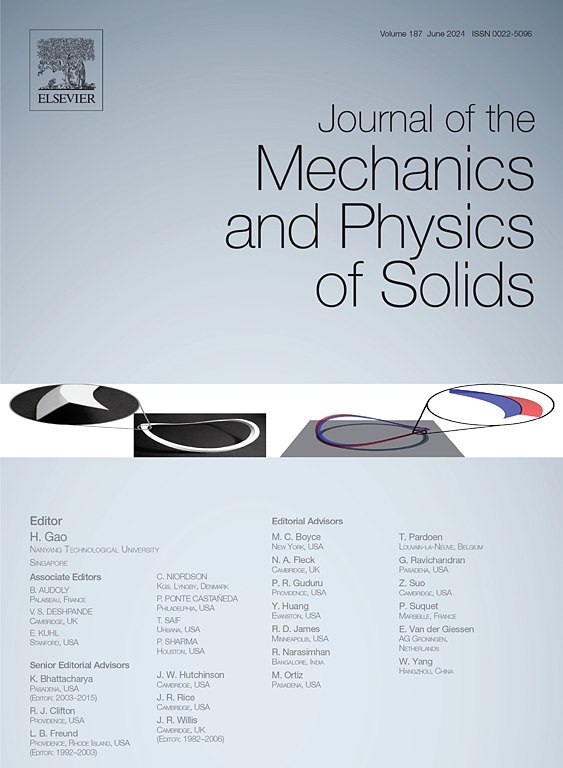非均质软材料断裂过程区与断裂能
IF 5
2区 工程技术
Q2 MATERIALS SCIENCE, MULTIDISCIPLINARY
引用次数: 0
摘要
仿生非均质软材料因其优异的抗断裂和抗疲劳性能而得到迅速发展。近年来,制备了几种不同长度尺度的纤维软复合材料。然而,这类材料的断裂行为和增韧机理尚不清楚。本文建立了纤维增强软质复合材料裂纹尖端场的理论模型。得到了裂纹扩展过程中裂纹尖端周围的变形分布和释放的弹性能。对断裂过程区和断裂能进行了量化。有一个临界样品高度,在此高度以下,断裂过程区尺寸和断裂能与尺寸相关,在此高度以上,它们接近于特定于材料的常数:稳态断裂过程区尺寸和稳态断裂能。导出了复合材料稳态断裂过程区尺寸与断裂参数的关系式。结果表明,复合材料的稳态断裂过程区尺寸和临界试样高度尺度均与断裂黏合长度有关。通过调整纤维几何形状,增大断裂过程区尺寸,或通过化学处理,增大纤维的断裂功,可以提高复合材料的稳态断裂能。本研究揭示了非均质软材料的增韧机理,为设计高断裂能、高疲劳阈值、低迟滞的软材料铺平了道路。为测量非均质软质材料稳态断裂能的试样尺寸确定提供了实用的指导。本文章由计算机程序翻译,如有差异,请以英文原文为准。
Fracture process zone and fracture energy of heterogeneous soft materials
Bio-inspired heterogeneous soft materials are under rapid development due to their superior fracture and fatigue resistance. In the last few years, several kinds of fibrous soft composites in different length scales have been fabricated. However, the fracture behavior and toughening mechanism of this class of materials are still elusive. Here we develop a theoretical model for the crack tip field of fiber reinforced soft composites. The distribution of deformation around the crack tip and released elastic energy during crack propagation are obtained. The fracture process zone and fracture energy are quantified. There is a critical sample height, below which the fracture process zone size and fracture energy are size-dependent, above which they approach material-specific constants: steady-state fracture process zone size and steady-state fracture energy. A formula is derived to relate the steady-state fracture process zone size and parameters of the composite. It is found that both the steady-state fracture process zone size and the critical sample height scale with the fractocohesive length of the composite. The steady-state fracture energy of the composite can be enhanced either by enlarging the fracture process zone size through tuning fiber geometry or by increasing the work to rupture of the fiber through chemical treatment. This work reveals the toughening mechanism of heterogeneous soft materials and paves the way to design soft materials of high fracture energy, high fatigue threshold, and low hysteresis. It also provides a practical guideline for determining the sample size to measure the steady-state fracture energy of heterogeneous soft materials.
求助全文
通过发布文献求助,成功后即可免费获取论文全文。
去求助
来源期刊
CiteScore
9.80
自引率
9.40%
发文量
276
审稿时长
52 days
期刊介绍:
The aim of Journal of The Mechanics and Physics of Solids is to publish research of the highest quality and of lasting significance on the mechanics of solids. The scope is broad, from fundamental concepts in mechanics to the analysis of novel phenomena and applications. Solids are interpreted broadly to include both hard and soft materials as well as natural and synthetic structures. The approach can be theoretical, experimental or computational.This research activity sits within engineering science and the allied areas of applied mathematics, materials science, bio-mechanics, applied physics, and geophysics.
The Journal was founded in 1952 by Rodney Hill, who was its Editor-in-Chief until 1968. The topics of interest to the Journal evolve with developments in the subject but its basic ethos remains the same: to publish research of the highest quality relating to the mechanics of solids. Thus, emphasis is placed on the development of fundamental concepts of mechanics and novel applications of these concepts based on theoretical, experimental or computational approaches, drawing upon the various branches of engineering science and the allied areas within applied mathematics, materials science, structural engineering, applied physics, and geophysics.
The main purpose of the Journal is to foster scientific understanding of the processes of deformation and mechanical failure of all solid materials, both technological and natural, and the connections between these processes and their underlying physical mechanisms. In this sense, the content of the Journal should reflect the current state of the discipline in analysis, experimental observation, and numerical simulation. In the interest of achieving this goal, authors are encouraged to consider the significance of their contributions for the field of mechanics and the implications of their results, in addition to describing the details of their work.

 求助内容:
求助内容: 应助结果提醒方式:
应助结果提醒方式:


